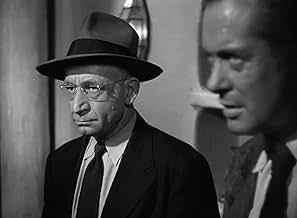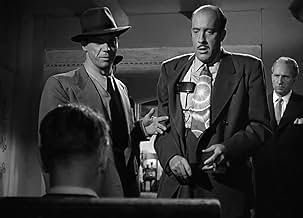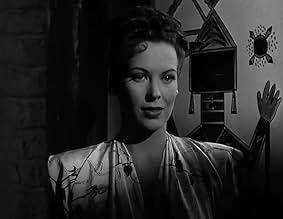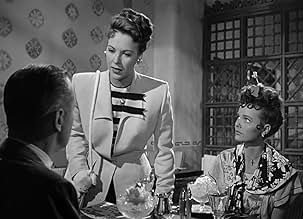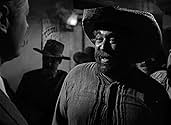AVALIAÇÃO DA IMDb
7,2/10
3,7 mil
SUA AVALIAÇÃO
Adicionar um enredo no seu idiomaWW2 veteran Lucky Gagin arrives in a New Mexico border-town intent on revenging against mobster Frank Hugo but FBI agent Bill Retz, who also wants Hugo, tries to keep Gagin out of trouble.WW2 veteran Lucky Gagin arrives in a New Mexico border-town intent on revenging against mobster Frank Hugo but FBI agent Bill Retz, who also wants Hugo, tries to keep Gagin out of trouble.WW2 veteran Lucky Gagin arrives in a New Mexico border-town intent on revenging against mobster Frank Hugo but FBI agent Bill Retz, who also wants Hugo, tries to keep Gagin out of trouble.
- Direção
- Roteiristas
- Artistas
- Indicado a 1 Oscar
- 1 vitória e 1 indicação no total
Jose Alvarado
- Mexican Boy
- (não creditado)
Jimmy Ames
- Thug
- (não creditado)
Connie Asins
- Vocalist
- (não creditado)
Avaliações em destaque
ROBERT MONTGOMERY never seemed quite as comfortable in tough guy roles as someone like Humphrey Bogart was--and this is a role that would have been ideal for Bogart. Not to say that Montgomery isn't effective--he's especially good in the latter part of the story where he must stagger around after a brutal beating. His direction too has to be commended, taut and keeping the sense of imminent danger lurking in the shadows at all times.
He plays a typical film noir character, struggling to wrong a right in a world where he feels alienated and suspicious of everyone. But it's a little too much of a one note performance with a sneer behind every sarcastic comment and never letting us know what he is really all about. That becomes true of the other characters too. We are never told why Wanda Hendrix (as a blue-eyed Mexican girl) follows him around so worshipfully after he has some rude exchanges with her. We never fully know why Pablo takes to him so instantly, enough to bear a brutal beating to keep his whereabouts a secret. Nor do we know why Art Smith follows him around at a respectful distance and seems to serve as his conscience when some expository dialogue trys to shed light on their characters. But keeping these characters as an enigma is partly what makes the film so fascinating.
Even the femme fatale is kept at a shadowy distance and Andrea King makes her an interesting woman whom we know has an ulterior motive in wanting to help Montgomery. Some extra tension is derived from the scene where Pablo (Thomas Gomez with a heavy Spanish accent) is brutally beaten while children nearby ride a carousel but become aware of their dangerous surroundings in the midst of a joyful ride.
Robert Montgomery is only partly successful as the bluntly outspoken tough guy and therein lies one of the film's chief faults. Furthermore, the low-key lighting cannot disguise the fact that almost all of the film's settings have a stagebound look to them, even the haven that Pablo supplies and where the carousel rides are taken. Most of the exteriors have that soundstage look with a rather stylized seediness to replicate a small Mexican town. It's an artificiality that cannot be ignored when watching the film.
Thomas Gomez won a Supporting Role Oscar nomination for his colorful Pablo. His thick accent reminds me of Akim Tamiroff and the other cave dwellers in Hemingway's FOR WHOM THE BELL TOLLS. Gomez gives Tamiroff a run for his money.
Summing up: a fascinating but ultimately unsatisfying film noir with an ending involving the Mexican girl that can only cause speculation. Was her true motive revealed? The answer remains obscure.
I can only repeat: what a role this would have been for Bogart!!
He plays a typical film noir character, struggling to wrong a right in a world where he feels alienated and suspicious of everyone. But it's a little too much of a one note performance with a sneer behind every sarcastic comment and never letting us know what he is really all about. That becomes true of the other characters too. We are never told why Wanda Hendrix (as a blue-eyed Mexican girl) follows him around so worshipfully after he has some rude exchanges with her. We never fully know why Pablo takes to him so instantly, enough to bear a brutal beating to keep his whereabouts a secret. Nor do we know why Art Smith follows him around at a respectful distance and seems to serve as his conscience when some expository dialogue trys to shed light on their characters. But keeping these characters as an enigma is partly what makes the film so fascinating.
Even the femme fatale is kept at a shadowy distance and Andrea King makes her an interesting woman whom we know has an ulterior motive in wanting to help Montgomery. Some extra tension is derived from the scene where Pablo (Thomas Gomez with a heavy Spanish accent) is brutally beaten while children nearby ride a carousel but become aware of their dangerous surroundings in the midst of a joyful ride.
Robert Montgomery is only partly successful as the bluntly outspoken tough guy and therein lies one of the film's chief faults. Furthermore, the low-key lighting cannot disguise the fact that almost all of the film's settings have a stagebound look to them, even the haven that Pablo supplies and where the carousel rides are taken. Most of the exteriors have that soundstage look with a rather stylized seediness to replicate a small Mexican town. It's an artificiality that cannot be ignored when watching the film.
Thomas Gomez won a Supporting Role Oscar nomination for his colorful Pablo. His thick accent reminds me of Akim Tamiroff and the other cave dwellers in Hemingway's FOR WHOM THE BELL TOLLS. Gomez gives Tamiroff a run for his money.
Summing up: a fascinating but ultimately unsatisfying film noir with an ending involving the Mexican girl that can only cause speculation. Was her true motive revealed? The answer remains obscure.
I can only repeat: what a role this would have been for Bogart!!
10SHAWFAN
I saw this film when I was a young boy when it first came out in 1947 but didn't truly appreciate it till I saw it on TCM the other night again. I agree with all your commentators as to its enigmatic mystery and its possible shortfalls attributable to Montgomery vis a vis Bogart. I found the dialogue and the monologues gripping. In later looking this movie up here I discovered why: the script was by Ben Hecht (of Front Page fame). No wonder it was so great. As many of your commentators point out (and very perceptively too) the individual performances of Gomez, Hendrix, Clark, etc. were all splendid, not to forget Montgomery himself. But TCM must have edited the film or else I fell asleep watching it: I definitely did not see Gomez being beaten up by anyone while being watched by uncomprehending children. That part was definitely not in the version that I watched, sad to say. One of the strongest parts of the film was the disillusionment and cynicism expressed by the Montgomery character against patriotism, and WWII and its profiteers in typical film-noir fashion. Also strikingly evocative and disturbing was the final scene in which the innocent-appearing and passive Hendrix character finally opens up to her friends and re-enacts the events of the film in a vivacious and cynical way to show her friends how sophisticated she is after all. What a dash of cold water in the face of those who expected a romantic ending between two such repressed characters who made a specialty out of never showing their emotions. A great, great movie.
From the film's opening scene, which shows the protagonist, Lucky Gagin, emerging from a bus into a dusty Mexican town, the viewer is hooked. There are so many good things about this film, primarily the acting performances -- Robert Montgomery is a standout, as are Wanda Hendrix, Fred Clark, Thomas Gomez, and Art Smith. They each completely occupy their characters and make them come to life. Another highlight is the dialogue -- there are numerous memorable exchanges between Montgomery and Hendrix, and Clark delivers two especially well-written diatribes that serve to solidify his character in the consciousness. The story itself is quite simple, and is driven far more by characterization than by plot, but that is what makes the film so good. The film also contains its share of classically dark noir imagery -- most memorable is the scene in which the Gomez character is savagely beaten by two hoods while a group of neighborhood children sail along on the nearby merry-go-round, at first gaily enjoying the free ride but growing increasingly somber and afraid as they witness the brutal attack. This one is a definite must-see, particularly for film noir buffs, but also for film lovers of all types.
This is a classic pseudo film noir. It means to emulate, but not necessarily be, a true film noir.
Robert Montgomery is excellent and believable as a man driven to revenge the death of his war time pal.
The scenes with Wanda Hendrix as, in turns, a guileless teen, a knowing friend and a woman who 'sees things' are taut and dramatic. There are a few moments of humor there too.
Mr Montgomery's direction is both intelligent and convincing. There are moments of drama. Moments of near pathos. Moments of comedy. Moments of boredom - from the characters, not the audience.
The 'Fed' and 'Pancho' the carousel owner are interesting and engaging characters. Not hollow or cardboard cutouts that one might see in some films.
All in all it is a very enjoyable film and a must see for those that appreciate both the acting skills and the directorial skills of Mr. Robert Montgomery.
Robert Montgomery is excellent and believable as a man driven to revenge the death of his war time pal.
The scenes with Wanda Hendrix as, in turns, a guileless teen, a knowing friend and a woman who 'sees things' are taut and dramatic. There are a few moments of humor there too.
Mr Montgomery's direction is both intelligent and convincing. There are moments of drama. Moments of near pathos. Moments of comedy. Moments of boredom - from the characters, not the audience.
The 'Fed' and 'Pancho' the carousel owner are interesting and engaging characters. Not hollow or cardboard cutouts that one might see in some films.
All in all it is a very enjoyable film and a must see for those that appreciate both the acting skills and the directorial skills of Mr. Robert Montgomery.
I don't really care very much for Robert Montgomery as a serious actor; they must have been at least a half dozen or more Hollywood actors at the time who could have handled the role better: Bogart, Cagney, Flynn, Power, Holden, Ford (etc). But despite being miscast, Montgomery pulls it off with some help from a great supporting cast. Great writing by a woman writer, Dorothy B Hughes, and a great screenplay by Lederer and Hecht (Lancaster's old buddy) provides the viewer with a real treat for atmosphere and storytelling. Gagin comes to New Mexico to square accounts with the guy who shot his partner, Shorty. Mr. Hugo is well-played by. Fred Clark. But the person who steals this film is not Montgomery, Clark or even Thomas Gomez, who was nominated for a Best Supporting Actor role as Pancho in the film. No, the film is stolen by actress, Wanda Hendrix as Pila, a wild-looking, space cadet, who is fiercely loyal to Gagin. One of the best film noir pieces you will ever see.
Você sabia?
- CuriosidadesFilmed in Santa Fe, the burning of Zozobra, which began in 1924, is still an annual festival occurring in September.
- Erros de gravaçãoOpening scene at the bus station, Montgomery walks over to the gum machine to insert his coin, but the gum package is already present before he inserts it.
- Cenas durante ou pós-créditosThe main title card reads, "as LUCKY GAGIN in RIDE THE PINK HORSE." The film's title is in far smaller type than the character name.
- ConexõesFeatured in Pulp Cinema (2001)
Principais escolhas
Faça login para avaliar e ver a lista de recomendações personalizadas
- How long is Ride the Pink Horse?Fornecido pela Alexa
Detalhes
- Data de lançamento
- País de origem
- Idiomas
- Também conhecido como
- Ride the Pink Horse
- Locações de filme
- Empresa de produção
- Consulte mais créditos da empresa na IMDbPro
Bilheteria
- Faturamento bruto nos EUA e Canadá
- US$ 2.000.000
- Tempo de duração1 hora 41 minutos
- Cor
- Proporção
- 1.37 : 1
Contribua para esta página
Sugerir uma alteração ou adicionar conteúdo ausente

Principal brecha
By what name was Do Lodo Brotou uma Flor (1947) officially released in India in English?
Responda
